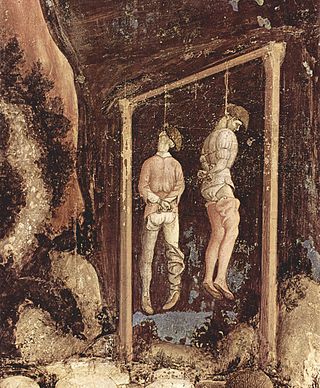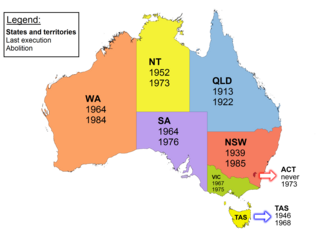
Hanging is killing a person by suspending them from the neck with a noose or ligature. Hanging has been a common method of capital punishment since the Middle Ages, and is the primary execution method in numerous countries and regions. The first known account of execution by hanging is in Homer's Odyssey. Hanging is also a method of suicide.

Capital punishment in the United Kingdom predates the formation of the UK, having been used within the British Isles from ancient times until the second half of the 20th century. The last executions in the United Kingdom were by hanging, and took place in 1964; capital punishment for murder was suspended in 1965 and finally abolished in 1969. Although unused, the death penalty remained a legally defined punishment for certain offences such as treason until it was completely abolished in 1998; the last execution for treason took place in 1946. In 2004, Protocol No. 13 to the European Convention on Human Rights became binding on the United Kingdom; it prohibits the restoration of the death penalty as long as the UK is a party to the convention.

Capital punishment was abolished via the legislative process on May 2, 2013, in the U.S. state of Maryland.
Capital punishment in Canada dates back to Canada's earliest history, including its period as a French colony and, after 1763, its time as a British colony. From 1867 to the elimination of the death penalty for murder on July 26, 1976, 1,481 people had been sentenced to death, and 710 had been executed. Of those executed, 697 were men and 13 women. The only method used in Canada for capital punishment of civilians after the end of the French regime was hanging. The last execution in Canada was the double hanging of Arthur Lucas and Ronald Turpin on December 11, 1962, at Toronto's Don Jail. The National Defence Act prescribed the death penalty for certain military offences until 1999, although no military executions had been carried out since 1946.
An execution chamber, or death chamber, is a room or chamber in which capital punishment is carried out. Execution chambers are almost always inside the walls of a maximum-security prison, although not always at the same prison where the death row population is housed. Inside the chamber is the device used to carry out the death sentence.
Capital punishment was abolished in 2019 in New Hampshire for persons convicted of capital murder. It remains a legal penalty for crimes committed prior to May 30, 2019.

Capital punishment – the process of sentencing convicted offenders to death for the most serious crimes and carrying out that sentence, as ordered by a legal system – first appeared in New Zealand in a codified form when New Zealand became a British colony in 1840. It was first carried out with a public hanging in Victoria Street, Auckland in 1842, while the last execution occurred in 1957 at Mount Eden Prison, also in Auckland. In total, 85 people have been lawfully executed in New Zealand.

A public execution is a form of capital punishment which "members of the general public may voluntarily attend." This definition excludes the presence of only a small number of witnesses called upon to assure executive accountability. The purpose of such displays has historically been to deter individuals from defying laws or authorities. Attendance at such events was historically encouraged and sometimes even mandatory.

Capital punishment in Sweden was last used in 1910, though it remained a legal sentence for at least some crimes until 1973. It is now outlawed by the Swedish Constitution, which states that capital punishment, corporal punishment, and torture are strictly prohibited. At the time of the abolition of the death penalty in Sweden, the legal method of execution was beheading. It was one of the last states in Europe to abolish the death penalty.

Capital punishment has been completely abolished in all European countries except for Belarus and Russia, the latter of which has a moratorium and has not carried out an execution since September 1996. The complete ban on capital punishment is enshrined in both the Charter of Fundamental Rights of the European Union (EU) and two widely adopted protocols of the European Convention on Human Rights of the Council of Europe, and is thus considered a central value. Of all modern European countries, San Marino, Portugal, and the Netherlands were the first to abolish capital punishment, whereas only Belarus still practises capital punishment in some form or another. In 2012, Latvia became the last EU member state to abolish capital punishment in wartime.

Capital punishment for murder was abolished in Cyprus on 15 December 1983. It was abolished for all crimes on 19 April 2002. The death penalty was replaced with life imprisonment. Cyprus is a signatory to the second optional protocol of the International Covenant on Civil and Political Rights, which provides for full abolition of capital punishment. Cyprus initially had a reservation on the second protocol, allowing execution for grave crimes in times of war, but subsequently withdrew this reservation. The Constitution of Cyprus was amended in 2016 to eliminate all forms of capital punishment.

Capital punishment in Australia has been abolished in all jurisdictions since 1985. Queensland abolished the death penalty in 1922. Tasmania did the same in 1968. The Commonwealth abolished the death penalty in 1973, with application also in the Australian Capital Territory and the Northern Territory. Victoria did so in 1975, South Australia in 1976, and Western Australia in 1984. New South Wales abolished the death penalty for murder in 1955, and for all crimes in 1985. In 2010, the Commonwealth Parliament passed legislation prohibiting the re-establishment of capital punishment by any state or territory. Australian law prohibits the extradition or deportation of a prisoner to another jurisdiction if they could be sentenced to death for any crime.
Capital punishment is a legal penalty in Israel. Capital punishment has only been imposed twice in the history of the state and is only to be handed out for treason, genocide, crimes against humanity, and crimes against the Jewish people during wartime. Israel is one of seven countries to have abolished capital punishment for "ordinary crimes only."
Capital punishment was abolished in Turkey in 2004, and no prisoners have been executed since October 1984. Before that, over 500 convicts sentenced to death were executed. The method of execution was hanging.

The island country of Jersey is a state in which capital punishment has been abolished.

The 1978 Spanish Constitution bans capital punishment in Spain, except for wartime offences. Spain completely abolished capital punishment for all offenses, including in times of war, in October 1995.
Hanging has been practiced legally in the United States of America from before the nation's birth, up to 1972 when the United States Supreme Court found capital punishment to be in violation of the Eighth Amendment to the United States Constitution. Four years later, the Supreme Court overturned its previous ruling, and in 1976, capital punishment was again legalized in the United States. As of 2023, only New Hampshire has a law specifying hanging as an available secondary method of execution, and even then only for the one remaining capital punishment sentence in the state.
Capital punishment in Montenegro was first prescribed by law in 1798. It was abolished on 19 June 2002. The last execution, by shooting, took place on 29 January 1981, and the two last death sentences were pronounced on 11 October 2001. Montenegro is bound by the following international conventions prohibiting capital punishment : Second Optional Protocol to the International Covenant on Civil and Political Rights, as well as Protocols No. 6 and No. 13 to the European Convention on Human Rights. Article 26 of the Montenegrin Constitution (2007) that outlawed the death penalty states: "In Montenegro, capital punishment punishment is forbidden”.

Capital punishment was abolished in Ukraine in 2000. In 1995 Ukraine entered the Council of Europe and thus was obliged to abolish the death penalty. The Verkhovna Rada introduced amendments to the then-acting Criminal Code in 2000, according to which "death penalty" was withdrawn from the list of official punishments of Ukraine. Ukraine carried out its last execution in 1997 according to Amnesty International.
Capital punishment is a legal penalty in Uganda. The death penalty was likely last carried out in 1999, although some sources say the last execution in Uganda took place in 2005. Regardless, Uganda is interchangeably considered a retentionist state with regard to capital punishment, due to absence of "an established practice or policy against carrying out executions," as well as a de facto abolitionist state due to the lack of any executions for over one decade.









